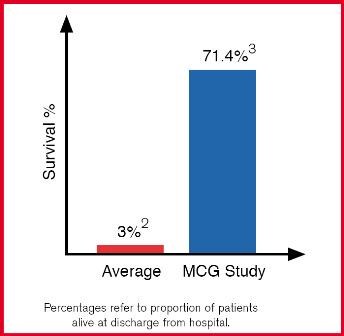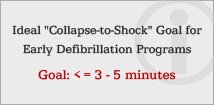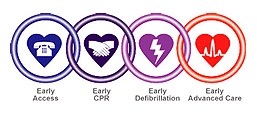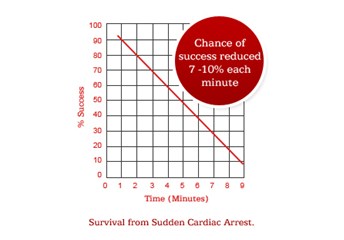The Importance of Early Defibrillation
Every Minute Counts.
Every Minute Counts
It is a proven concept that the only effective treatment for ventricular fibrillation (VF) is prompt defibrillation. Yet, defibrillation is only effective when it is administered within the first few minutes of a Sudden Cardiac Arrest (SCA) episode.
|
Chance of Survival
A study published in an October 2000 issue of the New England Journal of Medicine suggests that survival rates are highest when defibrillation is delivered within three minutes of the time of collapse.
This study is further backed up by a study of incidents at the MCG (Melbourne Cricket Ground, Victoria) and Shrine of Remembrance that showed that:
 "out of 28 victims of sudden cardiac arrest 86% left the venue alive", having been treated at the scene with a Laerdal HeartStart defibrillator. Compare this to the average survival rate in Australia of around 3%. "out of 28 victims of sudden cardiac arrest 86% left the venue alive", having been treated at the scene with a Laerdal HeartStart defibrillator. Compare this to the average survival rate in Australia of around 3%.
|
| - |
- |
|
Location is Key
Defibrillators are at the heart of any defibrillation program, and only through greater defibrillator availability will response times improve. Defibrillators have the potential to assume a role similar to that of the fire extinguisher - omnipresent and ready in case of emergency.
Although the deployment of defibrillators is becoming more widespread, they are not as prevalent as one might think. For instance, some estimates suggest that 90% of ambulances, 10-15% of first-response fire department vehicles, and less than 1% of police vehicles carry defibrillators.
|
 |
|
Through the widespread deployment of defibrillators within a community, the "collapse-to-shock" time can decrease and survival rates may increase. With these objectives in mind, program leaders often first bolster the defibrillator preparedness of their public safety providers, and then install devices in locations where large numbers of residents and visitors gather. Although there is no formula for determining the optimal number of defibrillators and their appropriate placement, deployment should be based on shortened response times and on SCA risk factors that exist within the population.
Look around where you live, where you work, and the places you frequent and determine how close you are to a defibrillator and a trained responder. Guidelines recommend three minutes to access a defibrillator. If an SCA victim can't be reached within this timeframe, It may be time to become a champion for early defibrillation, not only for your safety, but for others as well.
|
 |



 Australia
Australia





 "out of 28 victims of sudden cardiac arrest 86% left the venue alive", having been treated at the scene with a Laerdal HeartStart defibrillator. Compare this to the average survival rate in Australia of around 3%.
"out of 28 victims of sudden cardiac arrest 86% left the venue alive", having been treated at the scene with a Laerdal HeartStart defibrillator. Compare this to the average survival rate in Australia of around 3%.